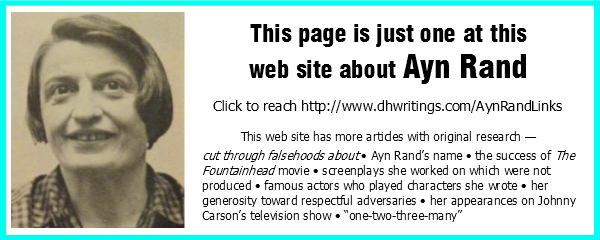Ayn Rand endorses a book in an ad
Many people have become so enamored of Ayn Rand’s writing that they seek everything of hers ever published. Few may have known (until now) that—as an author new to fame—her comment praising another contemporary book had been published in advertising for that other book.

The ad is for the novel This is My Brother. The novel, by Louis Paul, was copyrighted by Crown Publishers in 1943, and within two years hardback editions would published by World Publishing Company and Tower Books. None of these companies had published The Fountainhead (published 1943 as well), nor any prior Ayn Rand work, nor any of hers she was then preparing. The full ad, from which the above image is an enlarged detail, is reproduced below.

The ad was published in The New York Times on November 23, 1943, on page 22. Bookbuyers who found copies in stores would have seen on the covers that the book was described as “A dramatic story of a group of young American soldiers who courageously face torture and death at the hands of the Japanese.” America’s military conflict with “the land of the rising sun” was raging at the time.
Ayn Rand would, in the decades ahead, restrict the use of her name to promote the books of other authors. In 1968, Ayn Rand sued Hearst Corp. for its publishing on the jacket of one of its books (from its Avon Books imprint) an excerpt of a review which compared Ayn Rand's writings to that of the author of the book published by Hearst. The San Francisco Examiner had published a review which Avon/Hearst had excerpted to read “Ayn Rand enjoys … the same kind of mystique analysis as Vale … Their underlying drive is the same.” (“Vale” refers to Avon/Heart’s author.) The complaint filed on behalf of Rand says she “is well-known in the contemporary intellectual and literary world” and “among the public at large generally … possesses great fame as a writer.” She won when the case was first tried, but in 1969 lost on appeal.
The 2010 book 100 Voices: an Oral History of Ayn Rand contains an interview with an Ayn Rand attorney at the time, Eugene Winick, who discusses this court case briefly (pg. 318). News accounts and commentary about the final verdict can be found in Variety, April 2, 1969, pg, 76; and Publishers Weekly, March 31, 1969, pg. 35, and May 5, 1969, pgs. 23-24. The March 18, 1969, decision of the Appellate Division of the Supreme Court of the State of New York, First Department, can be retrieved from law resources by using the legal citation 31 A.D.2d 406.
In 1982, a blurb appeared on a book jacket which derived from written remarks that Ayn Rand had written specifically to endorse that book. The passage consists of two sentences excerpted from the introduction to the book. Ayn Rand wrote the four-page introduction to The Ominous Parallels: the End of Freedom in America, a book by Leonard Peikoff which the latter had been writing for about a dozen years when Ayn Rand dated the introduction November 1980. The passage selected to appear on the dust jacket reads:
If you do not wish to be a victim of today’s philosophical bankruptcy, I recommend The Ominous Parallels as protection and ammunition. It will protect you from supporting, unwittingly, the ideas that are destroying you and the world.
Although it might have happened that Ayn Rand would come to see her name used in an on-the-cover blurb where the use of her name met with her approval, that would not be. She had been alive throughout 1981, when the book was winding its way through the publishing process inside Stein and Day publishers. She passed away on March 6, 1982, before books had reached stores.
New content © 2014 David P. Hayes
